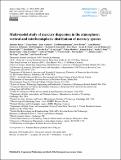Multi-model study of mercury dispersion in the atmosphere: vertical and interhemispheric distribution of mercury species
Author(s)
Bieser, Johannes; Slemr, Franz; Ambrose, Jesse; Brenninkmeijer, Carl; Brooks, Steve; Dastoor, Ashu; DeSimone, Francesco; Ebinghaus, Ralf; Gencarelli, Christian N.; Geyer, Beate; Gratz, Lynne E.; Hedgecock, Ian M.; Jaffe, Daniel; Kelley, Paul; Lin, Che-Jen; Jaegle, Lyatt; Matthias, Volker; Ryjkov, Andrei; Travnikov, Oleg; Weigelt, Andreas; Luke, Winston; Ren, Xinrong; Zahn, Andreas; Yang, Xin; Zhu, Yun; Pirrone, Nicola; Selin, Noelle E; Song, Shaojie; ... Show more Show less
Downloadacp-17-6925-2017.pdf (15.57Mb)
PUBLISHER_POLICY
Publisher Policy
Article is made available in accordance with the publisher's policy and may be subject to US copyright law. Please refer to the publisher's site for terms of use.
Terms of use
Metadata
Show full item recordAbstract
Atmospheric chemistry and transport of mercury play a key role in the global mercury cycle. However, there are still considerable knowledge gaps concerning the fate of mercury in the atmosphere. This is the second part of a model intercomparison study investigating the impact of atmospheric chemistry and emissions on mercury in the atmosphere. While the first study focused on ground-based observations of mercury concentration and deposition, here we investigate the vertical and interhemispheric distribution and speciation of mercury from the planetary boundary layer to the lower stratosphere. So far, there have been few model studies investigating the vertical distribution of mercury, mostly focusing on single aircraft campaigns. Here, we present a first comprehensive analysis based on various aircraft observations in Europe, North America, and on intercontinental flights. < br > < br > The investigated models proved to be able to reproduce the distribution of total and elemental mercury concentrations in the troposphere including interhemispheric trends. One key aspect of the study is the investigation of mercury oxidation in the troposphere. We found that different chemistry schemes were better at reproducing observed oxidized mercury patterns depending on altitude. High concentrations of oxidized mercury in the upper troposphere could be reproduced with oxidation by bromine while elevated concentrations in the lower troposphere were better reproduced by OH and ozone chemistry. However, the results were not always conclusive as the physical and chemical parameterizations in the chemistry transport models also proved to have a substantial impact on model results.
Date issued
2017-06Department
Massachusetts Institute of Technology. Department of Earth, Atmospheric, and Planetary Sciences; Massachusetts Institute of Technology. Institute for Data, Systems, and SocietyJournal
Atmospheric Chemistry and Physics
Publisher
Copernicus Publications
Citation
Bieser, Johannes et al. “Multi-Model Study of Mercury Dispersion in the Atmosphere: Vertical and Interhemispheric Distribution of Mercury Species.” Atmospheric Chemistry and Physics 17, 11 (June 2017): 6925–6955 © 2017 Author(s)
Version: Final published version
ISSN
1680-7324
1680-7316